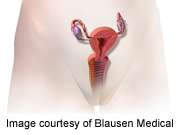There are no differences in cure rates after three years of follow-up between women receiving mesh or no mesh for vaginal prolapse repair, according to a study published online Sept. 6 in Obstetrics & Gynecology.
(HealthDay)—There are no differences in cure rates after three years of follow-up between women receiving mesh or no mesh for vaginal prolapse repair, according to a study published online Sept. 6 in Obstetrics & Gynecology.
Robert E. Gutman, M.D., from Georgetown University in Washington, D.C., and colleagues evaluated anatomic, symptomatic, and combined cure rates for 65 women randomized to traditional vaginal prolapse surgery without mesh and vaginal colpopexy repair with mesh (33 mesh and 32 no mesh). Participants were included if they had three-year validated quality-of-life questionnaires and two- or three-year postoperative blinded Pelvic Organ Prolapse Quantification examination. Those requiring reoperation for recurrent prolapse were not included in anatomic and subjective outcomes analysis.
The researchers prematurely halted the study as a result of a 15.6 percent mesh exposure rate. At three years of follow-up, three participants died, three required reoperation for recurrent prolapse (all in mesh group), and eight were lost to follow-up. There were no differences for prolapse stage or individual prolapse points between the groups at three years. Each group experienced significant stage improvement from baseline to three years (90 and 86 percent for mesh and no mesh, respectively). There were no differences in scores between groups for symptomatic improvement. Using a variety of definitions, cure rates, similarly, did not differ between groups. Anatomic cure was lowest for the anterior compartment.
"There was no difference in three-year cure rates when comparing patients undergoing traditional vaginal prolapse surgery without mesh with those undergoing vaginal colpopexy repair with mesh," the authors write.
Several authors disclosed financial ties to the medical device industry.
More information:
Abstract
Full Text (subscription or payment may be required)
Journal information: Obstetrics & Gynecology
Copyright © 2013 HealthDay. All rights reserved.




















